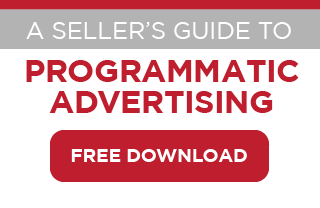By: Digital Media Training on December 4th, 2014
Programmatic Advertising Q&A with Keith Gooberman
Digital Media Landscape | Sales Tips | programmatic | Q and A series
 An exclusive interview with Keith Gooberman, CEO and founder of Programmatic Mechanics, to help you understand and gain more insight into programmatic advertising.
An exclusive interview with Keith Gooberman, CEO and founder of Programmatic Mechanics, to help you understand and gain more insight into programmatic advertising.
What is programmatic buying?
Programmatic buying is the process of purchasing one ad placement space in a real-time auction. It's initiated by the publisher who sends off a group of parameters including URL, placement, ad size, geographic location of the user (and others) to over 200 different ‘bidders’. These bidders then respond and the highest bidder wins the space. This happens individually for every ad loaded. The entire process takes under 150 milliseconds, while the average blink of an eye takes 350 milliseconds.
Why is it so effective?
It allows advertisers to eliminate waste by only targeting the ad space they want. The publisher wins because they are ensured the ad went to the highest possible bidder. This helps with overall yield management: the process of making sure they make the most revenue possible. Both sides win, and therefore it’s providing a solution.
When should I consider advertising this way?
Programmatic buying got its start as a direct-response tool. It has matured into a technique used for branding across all digital screens as the buyer still maintains precise control over the ads they purchase. Currently, these ‘pipes’ are starting to power all types of digital buying as it is ideal for both buyer and seller.
Which media channels support programmatic buying?
True programmatic buying is alive and healthy in display, SEM, mobile, video and social. It is gaining traction in digital OOH, online radio, native, and ever so slightly into linear cable.
How do I drive success with programmatic advertising?
Marketers need to prove their ads work. Programmatic buying allows advertisers to measure the actions a user takes after seeing an ad on the client’s website.
How do I ensure that my ads are served in brand-safe contexts?
The ‘trader’ or person with their hands on the controls should utilize basic settings to ensure the ads only run on a specific list of websites. Nearly every website on the web participates in the exchange in some manner. You cannot win the premium space on the top properties, but you can win space on ebay.com, kayak.com, cbs.com, abc.com, yahoo.com, nbc.com, etc.
Who are the major players in the programmatic landscape?
Google and AppNexus both have advanced technology available to the buy side and the sell side. Turn, MediaMath, and The Trade Desk all offer solutions to the buy side (marketers). Rubicon, Pubmatic, and OpenX offer solutions to the publisher side. Trading desks, Rocketfuel, and networks all offer IO (insertion order) based buying through programmatic means as well.
How has programmatic advertising changed in the last year and how do you envision it changing in the future?
Marketers and agencies are starting to get their hands dirty by using these platforms (“bringing it in house”). This means these groups are making deals directly with the platforms. Usually networks have sat between the buyers and the platforms, but because this is being bridged over, the margins in the middle are starting to fall. Ultimately the players left will resemble the SEM market – specialists who offer transparent buying services and a few massive technology players (Google in SEM, Google, AppNexus and Yahoo in display and mobile, Vistar Media in OOH, etc).
Are you or someone you know an expert in the digital space or sales? Do you want to be a part of our Q&A series? Tell us why! You might be featured in an email and our blog!




